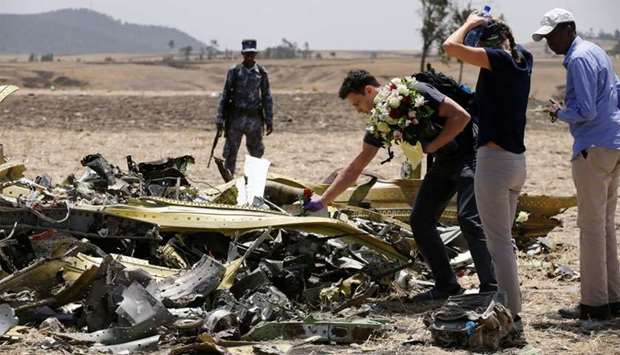After the crash of a Boeing 737 MAX 8 plane operated by Ethiopian Airlines on March 10, many countries and jurisdictions are grounding the narrow-body series aircraft over growing concerns about its safety.
It is the second time in less than six months that one of the planes has crashed within minutes of takeoff, after a new Lion Air Boeing 737 MAX 8 flight went down over the Java Sea October 2018, killing some 189 people.
However, the exact cause of March 10 Ethiopian jet crash is still unknown and there is no evidence of a link at this point between the two air disasters. But similarities in the incidents have obviously prompted caution among some airlines.
It may be months before investigators determine how the crashes happened and whether they are related.
Although a growing number of regulators across the globe too have expressed caution, the US Federal Aviation Administration has maintained the “continued airworthiness” of the model and they seemed to stand firmly behind Boeing.
There are approximately 350 Boeing 737 MAX 8 aircraft in operation worldwide, being flown by 54 operators, according to the US Federal Aviation Administration (FAA).
The Boeing 737 MAX 8 has been in commercial operation since 2016, data show.
Aviation experts say Boeing 737 has been a safe and stable workhorse of global airlines for more than 50 years. Much of the 737 MAX 8 aircraft and its systems are common to earlier variants.
Following the second of the two airplane crashes in the last five months, Boeing announced that it is updating 737 MAX 8 planes in the immediate future. The company has maintained that the model is indeed safe, but is making a few changes to its software system in the wake of the crashes that killed all passengers on board.
Following last October's Lion Air crash in Indonesia, investigators said the pilots had appeared to struggle with an automated system designed to keep the plane from stalling, dubbed as a new feature of the jet.
It is not yet clear whether the anti-stall system was the cause of last Sunday's crash at Bishoftu, less than 40km from Ethiopian capital Addis Ababa. Aviation experts say other technical issues or human error cannot be ruled out entirely.
Despite a barrage of questions and concerns from worried passengers since the Sunday crash, the fact remains flying continues to be the safest form of long distance travel the world has ever known.
Last year some 4.3bn passengers flew safely on 46.1mn flights, data provided by International Air Transport Association shows.
Based on the data, on average, a passenger could take a flight every day for 241 years before experiencing an accident with one fatality on board!
The industry suffered 523 passenger or crew deaths as a result of 11 fatal accidents in 2018, compared to an average of 8.8 fatal accidents and 234 fatalities in the preceding five-year period, and a record low of just six accidents causing 19 passenger/crew deaths in 2017.
Fatal accidents have fallen every decade since the 1950s, a significant achievement, given the massive growth in air travel since then.
Statistically, one has more chance of being killed riding a bicycle or even by lightning. The chances of dying in an air crash in developed or emerging markets are estimated to be 29mn to one.
But flying has become so safe that many travellers often take it for granted. Over the course of several decades, regulators and industry worked together to significantly reduce the risk of accidents and to improve airplane design, maintenance, training, and procedures.
Although aviation is seen as a very safe industry today, recent accidents have shown that vulnerabilities still exist.
Various stakeholders are now working on a project to totally eliminate midair collisions by 2020. It may seem an unlikely event that two airplanes would collide while flying, but history marks quite a few of these tragic events.
In recent years, however, thanks to technological advancements, midair collisions have become increasingly rare, especially for jets — and by next year, they are expected to reduce to near zero.
By then, nearly all aircraft will be mandated to be equipped with ADS-B (Automatic Dependent Surveillance-Broadcast) technology. The ADS-B devices — which can be installed on any aircraft, from the biggest airliner to the smallest private plane — provide signals that enable pilots to track all other aircraft in their vicinity on a screen in their cockpit, regardless of weather or visibility.
Another major initiative to ensure good safety performance in the commercial airline industry is a data-driven approach to identifying current and emerging risks.
Dubbed IATA’s Global Aviation Data Management program, GADM is the world’s most diverse aviation data exchange initiative of its kind. Data captured in GADM databases comprises accident and incident reports, ground damage occurrences and flight data from more than 470 different industry participants.
Undoubtedly, technology has made air travel safer. That said, aviation analysts have expressed fears that the safety paradigm could be compromised, when there are economic and performance pressures on the aviation industry.
Thousands of passengers depend on the aviation system to get them safely to their destinations, every day. For this reason, there should not be any complacency in respect of safety in the global aviation system.
Hence it is only appropriate that the investigation team share safety information concerning the aircraft with the governments, aviation regulators and travelling public.
*Pratap John is Business Editor at Gulf Times.




